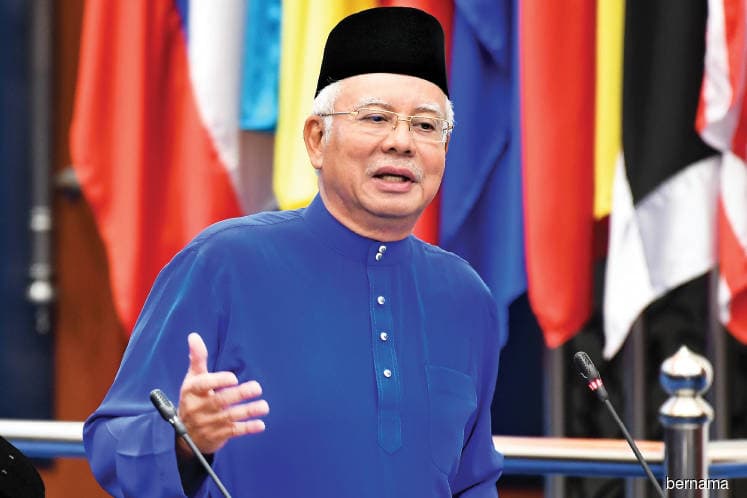
This article first appeared in The Edge Malaysia Weekly on October 30, 2017 - November 5, 2017
THE 2018 budget tabled last Friday by Prime Minister Datuk Seri Najib Razak was quickly labelled “rakyat-friendly” as it seemed to address a common complaint of Malaysians — the rising cost of living. Furthermore, it is the last to be tabled before the 14th general election that must be called by August next year.
Although the budget is filled with goodies for the rakyat, economists say it shows restraint and fiscal discipline.
“If you compare the 2018 budget with the 2013 budget (both pre-election), it is generous but the difference is that this time, it has been done in a measured way that reflects discipline,” says Affin Hwang Capital Research economist Alan Tan.
CIMB Research economist Michelle Chia concurs, saying, “The budget has been crafted with feedback from the public, especially in tackling the rising cost of living, creating new sources of income for the B40, assistance for the civil service, affordable housing, boosting public healthcare and improving infrastructure in the rural areas.”
The government is expecting to narrow its budget deficit target to 2.8% of gross domestic product next year; this year, the fiscal deficit is expected to shrink to 3% of GDP.
What came as a pleasant surprise to the M40 (middle 40% of the population) was an income tax rate reduction of 2% for those with taxable income within the RM20,000 to RM70,000 band. The reduction takes effect in the year of assessment 2018.
True, many had expected more tax relief from the government but not an outright rate reduction. In his budget speech, Najib said this measure would increase the disposable income of 2.3 million taxpayers in the M40 group by a total of RM1.5 billion or between RM300 and RM1,000 each.
Other crowd-pleasers were the abolition of toll at selected highway points, a RM1,500 bonus for civil servants, a RM750 special payment for pensioners, RM600 assistance for padi farmers and a minimum pension of RM1,000 per month.
FELDA settlers were not forgotten as Najib announced a special incentive payment of RM5,000 for them. The settlers will also receive 5,000 FELDA second-generation homes while the roads, water supply system and street lights in the settlements will be upgraded.
However, the budget fell short of corporate expectations — there was a lack of incentives for the sector. Axcelasia Taxand Sdn Bhd group executive chairman Veerinderjeet Singh believes a cut in the corporate tax rate would have spurred economic activity.
But CIMB’s Chia remarks that corporate tax rates were reduced for YA2017 and YA2018 in the 2017 budget. “Businesses, especially the smaller ones, should still benefit in 2018. Also, existing tax incentives and grants, like allowances and incentives for automation and capital expenditure, will continue to be made available in Budget 2018,” she says.
Nevertheless, Chartered Tax Institute of Malaysia president Seah Siew Yun opines that the goodies for individuals could come at a cost for employers.
Malaysian Employers Federation executive director Datuk Shamsuddin Bardan agrees, commenting that the SL1M Apprenticeship Programme, for example, would add to the employers’ costs. “Companies that get government deals will now have to plough back 1% of the contract value into the SL1M programmes, which is an additional cost for the companies. This comes on top of the allowances and costs incurred for training graduates,” he says.
Seah, who was expecting an announcement on the taxing of the digital economy, was disappointed. “Not much was mentioned about the digital economy other than the digital free trade zone. Taxing the digital economy is a challenge for many countries in the world. We are not sure how the IRB and Customs will be going about it,” she says.
Logistics, tourism sectors appear to be main beneficiaries
The tourism industry will be revitalised as the year 2020 has been declared a Visit Malaysia Year. Also, apart from the extension of tax incentive, some RM2 billion has been allocated to the SME Tourism Fund and RM1 billion to the Tourism Infrastructure and Development Fund. The healthcare tourism industry is getting tax deductions and special incentives as well.
As for the logistics sector, several airports, including the Pulau Pinang International Airport, will be upgraded while the government is studying the need for an airport in Pulau Tioman. Najib also announced that the government is studying a plan to build a bridge from Sabah to Labuan.
While the goodies were dished out with a commitment to reduce the fiscal deficit in mind, Moody’s Investor Service analyst Anushka Shah points out that the budget lacks revenue reforms.
“Meanwhile, expenditure measures are targeted at inclusive growth and high-multiplier spending, similar to what other governments are implementing in response to demands from the populations and electorates.
“The full credit implications of the budget will depend on whether the projected increase in revenue — the fastest since 2012 — is achievable since the targets rest primarily on a rise in GST collection, which, in turn, relies on relatively optimistic growth projections going into 2018,” says Anushka.
Revenue is expected to rise 6.4% from RM225.34 billion to RM239.86 billion this year with GST contributing about RM43.8 billion or 18% to total revenue.
Save by subscribing to us for your print and/or digital copy.
P/S: The Edge is also available on Apple's AppStore and Androids' Google Play.